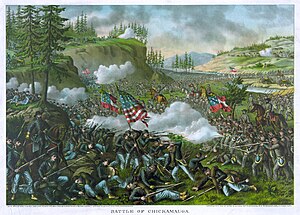
Back معركة تشيكاماوجا Arabic Emgann Chickamauga Breton Batalla de Chickamauga Catalan Slaget ved Chickamauga Danish Schlacht am Chickamauga German Batalla de Chickamauga Spanish Chickamaugako gudua Basque نبرد چیکاموگا Persian Chickamaugan taistelu Finnish Bataille de Chickamauga French
| Battle of Chickamauga | |||||||
|---|---|---|---|---|---|---|---|
| Part of the Western Theater of the American Civil War | |||||||
 The Battle of Chickamauga, a portrait by Kurz and Allison | |||||||
| |||||||
| Belligerents | |||||||
|
|
| ||||||
| Commanders and leaders | |||||||
|
|
| ||||||
| Units involved | |||||||
| Army of the Cumberland[4] | Army of Tennessee[5] | ||||||
| Strength | |||||||
| ~60,000[6][7] | ~65,000[8] | ||||||
| Casualties and losses | |||||||
|
16,170[9][10] 1,657 killed 9,756 wounded 4,757 captured or missing |
18,454[10] 2,312 killed 14,674 wounded 1,468 captured or missing | ||||||
Location within the state of Georgia | |||||||
The Battle of Chickamauga, fought on September 18–20, 1863, between the United States Army and Confederate forces in the American Civil War, marked the end of a U.S. Army offensive, the Chickamauga Campaign, in southeastern Tennessee and northwestern Georgia.[1][2] It was the first major battle of the war fought in Georgia, the most significant US defeat in the Western Theater, and involved the second-highest number of casualties after the Battle of Gettysburg.
The battle was fought between the US Army Army of the Cumberland under Maj. Gen. William Rosecrans and the Confederate Army of Tennessee under Gen. Braxton Bragg, and was named for Chickamauga Creek. The West Chickamauga Creek meanders near and forms the southeast boundary of the battle area and the park in northwest Georgia. (The South Chickamauga ultimately flows into the Tennessee River about 3.5 miles (5.6 km) northeast of downtown Chattanooga).
After his successful Tullahoma Campaign, Rosecrans renewed the offensive, aiming to force the Confederates out of Chattanooga. In early September, Rosecrans consolidated his forces scattered in Tennessee and Georgia and forced Bragg's army out of Chattanooga, heading south. The Union troops followed it and brushed with it at Davis's Cross Roads. Bragg was determined to reoccupy Chattanooga and decided to meet a part of Rosecrans's army, defeat it, and then move back into the city. On September 17 he headed north, intending to attack the isolated XXI Corps. As Bragg marched north on September 18, his cavalry and infantry fought with Union cavalry and mounted infantry, which were armed with Spencer repeating rifles. The two armies fought at Alexander's Bridge and Reed's Bridge, as the Confederates tried to cross the West Chickamauga Creek.
Fighting began in earnest on the morning of September 19. Bragg's men strongly assaulted but could not break the US line. The next day, Bragg resumed his assault. In late morning, Rosecrans was misinformed that he had a gap in his line. In moving units to shore up the supposed gap, Rosecrans accidentally created an actual gap directly in the path of an eight-brigade assault on a narrow front by Confederate Lt. Gen. James Longstreet, whose corps had been detached from the Army of Northern Virginia. In the resulting rout, Longstreet's attack drove one-third of the U.S. army, including Rosecrans himself, from the field.
U.S. Army units spontaneously rallied to create a defensive line on Horseshoe Ridge ("Snodgrass Hill"), forming a new right wing for the line of Maj. Gen. George H. Thomas, who assumed overall command of remaining forces. Although the Confederates launched costly and determined assaults, Thomas and his men held until twilight. Union forces then retired to Chattanooga while the Confederates occupied the surrounding heights, besieging the city.
- ^ a b The NPS battle description Archived January 11, 2006, at the Wayback Machine by the Civil War Sites Advisory Commission and Kennedy, p. 227, cite September 15-20 However, fighting on September 18 was relatively minor in comparison to the following two days and only small portions of the armies were engaged. The Official Records of the war list September 18 activities as "Skirmishes at Pea Vine Ridge, Alexander's and Reed's Bridges, Dyer's Ford, Spring Creek, and near Stevens' Gap, Georgia." Chickamauga is almost universally referred to as a two-day battle, fought on September 19–20.
- ^ a b Martin, pp. 291–294
- ^ NPS battle description
- ^ Official Records, Series I, Volume XXX, Part 1, pp. 40–47
- ^ Official Records, Series I, Volume XXX, Part 2, pp. 11–20
- ^ Official Records, Series I, Volume XXX, Part 1, p. 169
- ^ Cite error: The named reference
Ustrengthwas invoked but never defined (see the help page). - ^ Cite error: The named reference
Cstrengthwas invoked but never defined (see the help page). - ^ Official Records, Series I, Volume XXX, Part 1, p. 179
- ^ a b Eicher, p. 590; Welsh, p. 86.
© MMXXIII Rich X Search. We shall prevail. All rights reserved. Rich X Search

